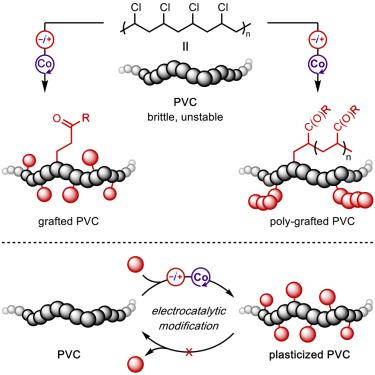Chem ( IF 19.1 ) Pub Date : 2024-09-19 , DOI: 10.1016/j.chempr.2024.08.021 Jordan L.S. Zackasee , Valmuri Srivardhan , Blaise L. Truesdell , Elizabeth J. Vrana , Christo S. Sevov

|
Polyvinyl chloride (PVC) plastics require high loadings of plasticizers and stabilizers to achieve commercially useful bulk properties. However, these non-covalent additives leach from PVC over time, resulting in the loss of their tailored functionality. This work details the electrocatalytic functionalization of PVC to covalently graft plasticizing additives directly onto the polymer backbone. Here, mechanistic insights guided the design of electrocatalysts capable of modifying C–Cl bonds of PVC under mild conditions with high selectivity while suppressing side reactions such as elimination and chain scission. Functional groups that mimic PVC plasticizers are covalently installed into the backbone of PVC to create new materials with distinct bulk properties from the original polymer. The degree of polymer grafting is easily controlled by simply changing the redox capacity that is passed during electrolysis. This strategy is employed to create chemically and leach-resistant PVC materials by directly electrolyzing mixtures of consumer PVC products.
中文翻译:

聚氯乙烯塑料的电催化接枝
聚氯乙烯 (PVC) 塑料需要大量增塑剂和稳定剂才能实现商业上有用的整体性能。然而,随着时间的推移,这些非共价添加剂会从 PVC 中浸出,导致其定制功能的丧失。这项工作详细介绍了 PVC 的电催化功能化,将增塑添加剂直接共价接枝到聚合物主链上。在这里,机理见解指导了电催化剂的设计,该催化剂能够在温和条件下以高选择性修饰 PVC 的 C-Cl 键,同时抑制消除和断链等副反应。模仿 PVC 增塑剂的官能团被共价安装到 PVC 的主链中,以创造出具有与原始聚合物不同的整体特性的新材料。通过简单地改变电解过程中通过的氧化还原容量,可以轻松控制聚合物接枝程度。该策略用于通过直接电解消费 PVC 产品的混合物来制造耐化学腐蚀和耐浸出的 PVC 材料。


















































 京公网安备 11010802027423号
京公网安备 11010802027423号